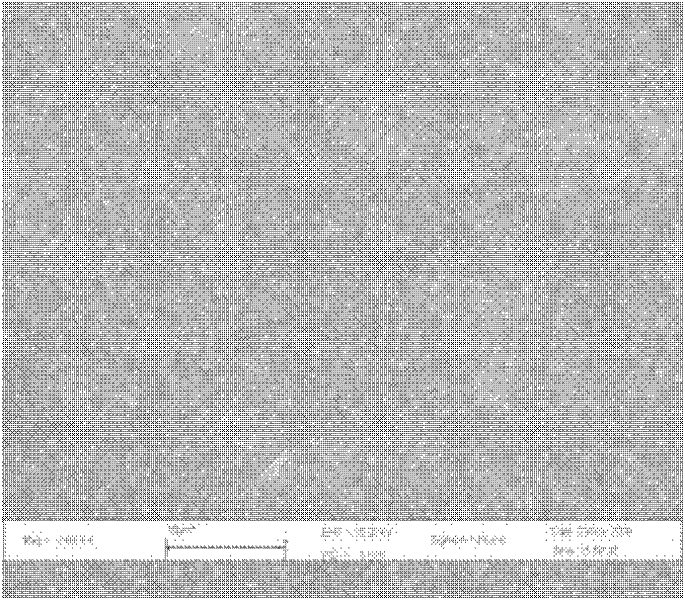Method for coloring titanium and titanium alloy surface through anodization
A technology of anodizing and titanium alloy, which is applied in the field of anodizing and coloring technology on the surface of titanium and titanium alloy, can solve the problems of unfavorable safety production, fingerprint pollution color, affecting decoration effect, etc., and achieve good practical application prospects, good corrosion resistance, The effect of good decorative effect
- Summary
- Abstract
- Description
- Claims
- Application Information
AI Technical Summary
Problems solved by technology
Method used
Image
Examples
Embodiment 1
[0030] 1) Alkaline washing to remove oil. At room temperature, add sodium carbonate (20g), sodium phosphate (20g) and sodium silicate (10g) in turn to deionized aqueous solution (1L), and heat to 80°C after the dissolution is complete. Two identical TC4 titanium alloy samples with a size of 10mm×10mm×2mm were put into the alkaline cleaning solution for continuous ultrasonic stirring. After 15 minutes of treatment, they were taken out and washed with flowing deionized water until a uniform water film formed on the surface of the samples.
[0031] 2) Electrolytic polishing. At room temperature, add 200g of sulfamic acid, 1L of formamide and 0.5g of cetyltrimethylammonium bromide to the electrolytic cell (1.5L) to prepare an electrolytic polishing solution; Put the titanium alloy A in this polishing electrolyte, with the sample as the anode and the stainless steel mesh as the cathode, apply a voltage of 15V and 10A·dm -2 Current density, take it out after 50s of treatment; and wa...
Embodiment 2
[0045]1) Alkaline washing to remove oil, at room temperature, add sodium carbonate (20g), sodium phosphate (20g), sodium silicate (15g) in turn to deionized aqueous solution (1L), and heat to 70°C after the dissolution is complete. Put the workpiece into the solution and continue ultrasonic stirring, take it out after 15 minutes of treatment, and wash it with flowing deionized water until a uniform water film is formed on the surface of the sample.
[0046] 2) Electrolytic polishing, at 25°C, put the titanium workpiece after alkaline cleaning into the electrolytic polishing solution of Example 1, with the sample as the anode and the titanium mesh as the cathode, apply a voltage of 35V and 15A dm -2 Current density, take it out after 6 minutes of treatment, and clean it with flowing deionized water.
[0047] 3) Anodizing coloring, at 25°C, add 45g of sodium silicate, 15g of tartaric acid, and 5g of glycerol in deionized aqueous solution (800mL) while stirring, and then add deio...
Embodiment 3
[0056] 1) Alkaline washing and degreasing, same as Example 2.
[0057] 2) Electropolishing. At 20°C, add 200g of sulfamic acid, 1L of formamide, 0.5g of cetyltrimethylammonium bromide, and 0.05g of surfactant to the electrolytic cell (1.5L) to prepare electrolytic polishing. Polishing solution; put the titanium alloy sample after degreasing treatment into the polishing electrolyte, with the sample as the anode and the titanium mesh as the cathode, apply a voltage of 20V and 10A·dm -2 Current density, take it out after 50s of treatment; and clean it with flowing deionized water.
[0058] 3) Anodizing coloring, at 25°C, add 40g of sodium silicate, 10g of tartaric acid, and 2g of glycerol in deionized aqueous solution (800mL) under stirring, and then add deionized water to 1L to prepare an anodic oxidation coloring solution. Put the titanium alloy after the above treatment into the solution, use the stainless steel plate as the cathode, and the titanium alloy as the anode, apply...
PUM
 Login to View More
Login to View More Abstract
Description
Claims
Application Information
 Login to View More
Login to View More - Generate Ideas
- Intellectual Property
- Life Sciences
- Materials
- Tech Scout
- Unparalleled Data Quality
- Higher Quality Content
- 60% Fewer Hallucinations
Browse by: Latest US Patents, China's latest patents, Technical Efficacy Thesaurus, Application Domain, Technology Topic, Popular Technical Reports.
© 2025 PatSnap. All rights reserved.Legal|Privacy policy|Modern Slavery Act Transparency Statement|Sitemap|About US| Contact US: help@patsnap.com



